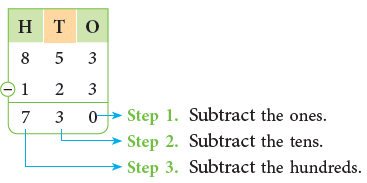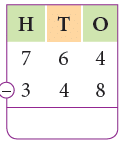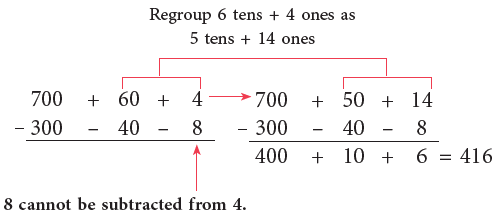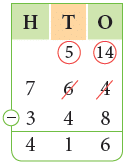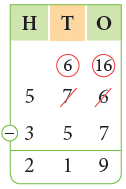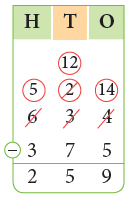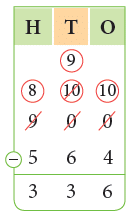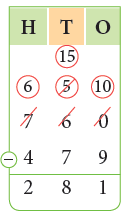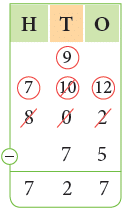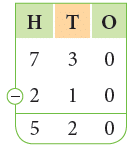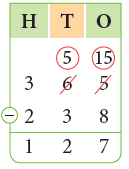Subtraction Class 2 Notes Maths
What is Subtraction?
- Subtraction is when we take away something from a group to find out how much is left. It’s like solving a little puzzle!
- For example, if you have 5 apples and you eat 3 apples, you’ll have 2 apples left. We can also say:
5 - 3 = 2 - Think of it like this: Imagine you have 10 balloons. If 4 balloons fly away, how many do you still have? That’s subtraction!
- It’s fun to practice subtraction with things like candies, toys, or even your fingers. It helps us when we share or figure out how much is left after we give something away!

Properties of Subtraction
Property 1: If we subtract 0 from a number, the number stays the same.
Example: 3 - 0 = 3
Property 2: If we subtract 1 from a number, we get the number that comes right before it.
Example: 8 - 1 = 7 and 9 - 1 = 8
Property 3: If a number is subtracted from itself, the result is always 0.
Example: 5 - 5 = 0 and 7 - 7 = 0.
Subtracting 3-Digit Numbers (Without Borrowing)
Let us learn subtraction directly through the following example:
Subtract 243 from 564.

Method 1: Using the Expanded Form
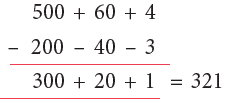
Method 2: Using the Short Form
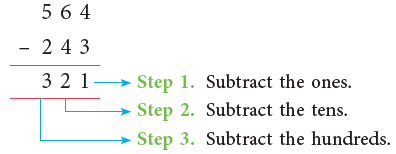
Example 1: Subtract 123 from 853.
Step 1. Arrange the numbers in the columns of hundreds, tens and ones.
Step 2. Subtract the ones.
3 ones – 3 ones = 0 ones
Step 3. Subtract the tens.
5 tens – 2 tens = 3 tens
Step 4. Subtract the hundreds.
8 hundreds – 1 hundred = 7 hundreds
So, 853 – 123 = 730.
Subtraction of 3-Digit Numbers (With Borrowing)
From Tens to Ones
Subtract 348 from 764.
To help you understand better the working is shown pictorially below.
Example 2: Subtract 357 from 576.
Step 1. Arrange the numbers in the columns of hundreds, tens and ones.
Step 2. Subtract the ones.
As we cannot subtract 7 ones from 6 ones,
we regroup 76 as 7 tens + 6 ones = 6 tens + 16 ones
Now, subtract 7 ones from 16 ones to get 9 ones.
Step 3. Subtract the tens.
6 tens – 5 tens = 1 ten
Step 4. Subtract the hundreds.
5 hundreds – 3 hundreds = 2 hundreds
So, 576 – 357 = 219.
From Hundreds to Tens and Tens to Ones

- 9 ones cannot be subtracted from 6 ones. So, we borrow 1 ten = 10 ones.
- 8 tens cannot be subtracted from 5 tens. So, we borrow 1 hundred = 10 tens.

We borrow from the hundreds column to the tens column and from the tens column to the ones column.
Example 3: Subtract 375 from 634.
Step 1. Arrange the numbers in the columns of hundreds, tens and ones.
Step 2. Subtract the ones.
As we cannot subtract 5 ones from 4 ones. So, we regroup.
34 = 3 tens + 4 ones = 2 tens + 14 ones
Now, subtract 5 ones from 14 ones to get 9 ones
Step 3. Subtract the tens.
As we cannot subtract 7 tens from 2 tens,
we regroup 6 hundreds 2 tens as 5 hundreds 12 tens.
Now, subtract 7 tens from 12 tens to get 5 tens.
Step 4. Subtract the hundreds.
5 hundreds – 3 hundreds = 2 hundreds.
So, 634 – 375 = 259.
Example 4: Subtract 564 from 900.
Step 1. Arrange the numbers in the columns of hundreds, tens and ones.
Step 2. As we cannot subtract 4 ones from 0 ones. So, we regroup.
Here, there is no tens, so first we regroup 9 hundreds as
8 hundreds + 1 hundred or
8 hundreds + 10 tens.
Now, we regroup 10 tens as 9 tens + 1 ten.
Again regroup 1 ten as 10 ones.
Now, subtract columnwise.
10 ones – 4 ones = 6 ones
9 tens – 6 tens = 3 tens
8 hundreds – 5 hundreds = 3 hundreds
So, 900 – 564 = 336.
Example 5: Subtract 75 from 802.
In this case, first borrow 1 hundred from 8 hundreds. Then, in place of 0 tens you have 10 tens in tens column. Now, borrow 1 ten = 10 ones to ones column.
Terms Related to Subtraction
In a subtraction problem,
- the number to be subtracted is called subtrahend.
- the number from which the smaller number is subtracted is called minuend.
- and the result is called the difference.
We can check the answer to a subtraction problem by addition.
We add the difference of the given numbers to the subtrahend.
If the sum is equal to minuend, our answer is correct.
Example 6: Subtract 147 from 603 and check your answer.
Check: We have, 147 + 456 = 603, so, our answer is correct
Problem Based on Real-Life Situations
Example 7: Preeti had ₹ 730. She bought a dress worth ₹ 210. How much money is she left with her?
Money Preeti had = ₹ 730
Money spent on dress = ₹ 210
Money left with her = ₹ 730 – 210 = ₹ 520.
So, money left with Preeti is ₹ 520.
days are the holidays? [Hint: The year 2019 has 365 days.]
|
17 videos|138 docs|19 tests
|
FAQs on Subtraction Class 2 Notes Maths
| 1. What is the process for subtracting 3-digit numbers without borrowing? |  |
| 2. How do you perform subtraction of 3-digit numbers that require borrowing? |  |
| 3. Can you explain the concept of borrowing in subtraction with an example? |  |
| 4. What should I do if I encounter a zero in the tens or ones place while borrowing? |  |
| 5. Are there any tips to practice and improve subtraction skills for 3-digit numbers? |  |


